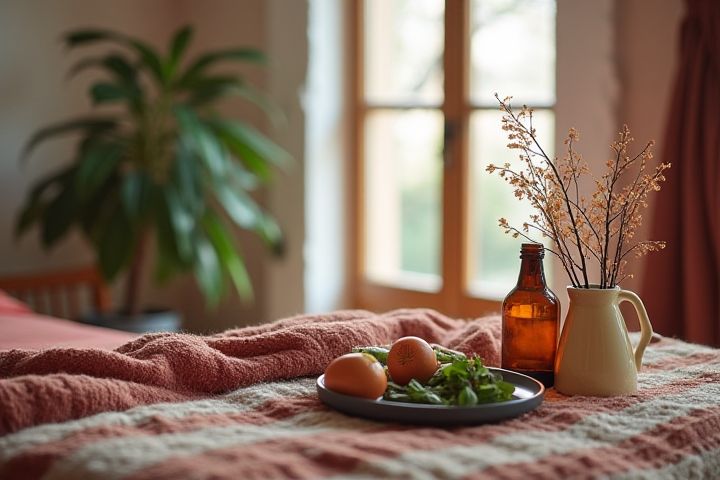
Warm colors such as reds, oranges, and yellows can create a cozy atmosphere in your home. Shades of beige and warm browns also contribute to an inviting environment while providing a neutral backdrop. Accents in deep jewel tones like ruby or amethyst can enhance the warmth without overpowering the space. When selecting colors, consider the natural light in your rooms, as it can influence how the colors appear throughout the day. Incorporating warm colors in furnishings and decor will further amplify the comforting feel of your living areas.
What Colors Make A House Warmer
Earthy tones
Earthy tones such as terracotta, warm taupe, and rich ochre bring a sense of warmth and comfort to a home's exterior and interior spaces. These colors evoke a connection to nature, often found in materials like clay and stone, creating an inviting atmosphere. Choosing shades like subdued rust or soft olive can help your home blend harmoniously with its surroundings while enhancing its visual appeal. Using these natural hues can significantly influence climate comfort, potentially lowering heating costs during colder months by absorbing sunlight and radiating warmth.
Warm yellows
Warm yellows, such as sunflower yellow or buttery gold, can infuse a home with a sense of coziness and energy. These shades reflect natural sunlight effectively, creating an inviting atmosphere that can brighten up even the gloomiest days. Incorporating warm yellows in your interior decor, like wall paint or accent pieces, can enhance feelings of happiness and comfort. When paired with complementary colors like soft greens or warm grays, warm yellows can create a harmonious balance that exudes warmth throughout your living space.
Rich reds
Rich reds, such as burgundy or crimson, can create a sense of warmth and coziness in your home. These bold hues evoke feelings of comfort and intimacy while stimulating emotional responses, making spaces feel more inviting. When used judiciously, rich reds can accentuate architectural features, enhance your decor, and create focal points that draw the eye. Consider incorporating these shades in living areas or dining spaces to foster a warm and engaging atmosphere for you and your guests.
Deep oranges
Deep oranges, such as burnt sienna or pumpkin, create an inviting and cozy atmosphere in a home, making spaces feel warmer. These rich hues can evoke feelings of energy and enthusiasm while promoting relaxation during colder months. Combining deep orange with earthy tones like browns and creams enhances the warmth, stimulating a sense of comfort. If you're looking to transform your living space, consider using deep oranges on accent walls, textiles, or decorative elements to achieve a welcoming vibe.
Warm terracottas
Warm terracottas, characterized by their earthy orange and reddish tones, create a cozy atmosphere in any home. These hues can range from soft clay shades to deep burnt orange, effectively promoting warmth and comfort. Utilizing warm terracotta in your exterior design can enhance your home's curb appeal, blending well with natural surroundings while reflecting sunlight for a soothing aesthetic. When paired with creamy whites or light neutrals, terracotta can also highlight architectural features, elevating your living space's overall inviting feel.
Soft browns
Soft browns, when used in home exteriors, create an inviting and warm atmosphere that enhances curb appeal. These earthy tones can achieve an inviting look, especially when combined with complementary colors like cream or beige, which accentuate architectural details. Using soft browns on surfaces such as doors, shutters, or trim adds depth and richness, making your home feel cozy and inviting. A soft brown palette can also reflect natural surroundings, harmonizing your home with landscapes while promoting a sense of tranquility.
Warm beiges
Warm beiges create an inviting atmosphere for your home, blending subtle undertones of yellow and orange that enhance the feeling of warmth. Popular shades such as sandy beige and honey beige evoke the cozy ambiance of a sunlit room, making spaces feel more welcoming. When paired with natural materials like wood or stone, these beiges can emphasize the warmth further, particularly in living rooms or kitchens that serve as social hubs. Opting for warm beige as a primary color can also increase the perceived value of your property, appealing to potential buyers with its timeless aesthetic.
Golden hues
Golden hues, such as deep yellows, warm ambers, and rich ochres, can significantly enhance the warmth of your home. These colors reflect sunlight effectively, creating an inviting and cozy atmosphere. Paint colors like buttery yellow or golden mustard can make spaces feel more vibrant and cheerful, especially in rooms with limited natural light. Incorporating golden accents in furnishings or decor can further amplify this warmth, promoting a sense of comfort for you and your guests.
Warm taupes
Warm taupes, characterized by a blend of brown and gray undertones, create an inviting atmosphere for your home. This versatile shade pairs beautifully with earthy tones and soft whites, promoting a cozy environment that is both modern and timeless. When used on exterior walls or in living spaces, warm taupes can enhance natural light, making rooms feel more spacious and welcoming. Studies suggest that homes featuring warm color palettes tend to evoke feelings of comfort and security, making taupe an excellent choice for fostering a warm ambiance.
Rust colors
Rust colors such as burnt orange, terracotta, and deep auburn can create an inviting warmth for your home's exterior. When combined with earthy tones like mustard yellow or muted browns, these hues contribute to a cozy and harmonious aesthetic. Choosing a rust palette can enhance architectural features, drawing attention to details while fostering a welcoming atmosphere. To further intensify the warmth, consider adding accents in complementary colors, ensuring your home stands out in a vibrant yet grounded way.
